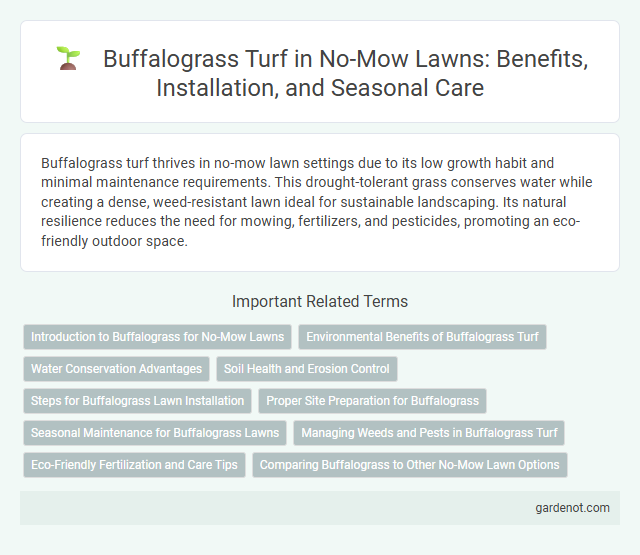Buffalograss turf thrives in no-mow lawn settings due to its low growth habit and minimal maintenance requirements. This drought-tolerant grass conserves water while creating a dense, weed-resistant lawn ideal for sustainable landscaping. Its natural resilience reduces the need for mowing, fertilizers, and pesticides, promoting an eco-friendly outdoor space.
Introduction to Buffalograss for No-Mow Lawns
Buffalograss is a drought-tolerant, low-maintenance turf grass ideal for no-mow lawns due to its slow growth rate and minimal water needs. Native to the North American Great Plains, Buffalograss thrives in full sun and sandy soils, creating a dense, soft green carpet that suppresses weeds naturally. Its deep root system enhances soil health and reduces the frequency of mowing, making it an eco-friendly choice for sustainable landscaping.
Environmental Benefits of Buffalograss Turf
Buffalograss turf significantly reduces water consumption due to its deep root system that thrives on natural rainfall, minimizing irrigation needs. Its low maintenance requirements also cut down on fossil fuel emissions by reducing the frequency of mowing and chemical application. Buffalograss supports local biodiversity by providing habitat for native insects and soil organisms, enhancing overall ecosystem health.
Water Conservation Advantages
Buffalograss turf requires significantly less water compared to traditional grass species, reducing overall irrigation needs by up to 60%. Its deep root system enhances soil moisture retention, promoting drought tolerance and minimizing water waste. This water-efficient characteristic makes Buffalograss an ideal choice for sustainable, low-maintenance lawns in arid and semi-arid regions.
Soil Health and Erosion Control
Buffalograss turf promotes superior soil health by enhancing microbial activity and increasing organic matter content, which strengthens soil structure and fertility. Its deep, dense root system effectively reduces soil erosion by stabilizing the ground surface and preventing runoff during heavy rains. This drought-tolerant grass species minimizes soil degradation while maintaining a resilient and low-maintenance lawn.
Steps for Buffalograss Lawn Installation
Prepare the soil by clearing debris, tilling to loosen it, and leveling the area to ensure proper drainage. Lay Buffalograss sod or plant plugs spaced 12 to 18 inches apart, then water thoroughly to promote root establishment. Maintain the lawn with minimal mowing, typically once every 2 to 3 weeks, and avoid excessive fertilization to preserve Buffalograss's drought-tolerant characteristics.
Proper Site Preparation for Buffalograss
Proper site preparation for Buffalograss turf involves thorough soil testing to ensure a pH between 6.0 and 7.5 and the correction of nutrient deficiencies with balanced fertilizers. Removing existing vegetation and debris, followed by tilling the soil to a depth of 4 to 6 inches, promotes healthy root establishment. Achieving a smooth, firm seedbed free of rocks and clumps enhances Buffalograss germination and turf uniformity.
Seasonal Maintenance for Buffalograss Lawns
Buffalograss lawns require minimal seasonal maintenance, thriving with annual mowing reduced to once every two to three weeks during the growing season. Fertilization is best applied in early spring with a low-nitrogen formula to promote healthy root development and drought resistance. Fall preparation involves applying a light topdressing and overseeding sparse areas to maintain turf density and resilience.
Managing Weeds and Pests in Buffalograss Turf
Effective weed and pest management in Buffalograss turf involves regular monitoring for invasive species such as crabgrass and sod webworms. Implementing integrated pest management (IPM) practices, including biological controls and selective herbicides, helps maintain healthy, resilient Buffalograss by minimizing chemical use. Proper mowing height and irrigation techniques also reduce stress on the turf, enhancing its natural ability to outcompete weeds and resist pest infestations.
Eco-Friendly Fertilization and Care Tips
Buffalograss turf requires minimal fertilization, making it an eco-friendly choice for sustainable lawns. Applying slow-release, organic fertilizers in early spring enhances soil health while reducing chemical runoff. Proper watering, limited to deep and infrequent irrigation, supports drought tolerance and conserves water resources.
Comparing Buffalograss to Other No-Mow Lawn Options
Buffalograss turf stands out among no-mow lawn options due to its exceptional drought tolerance and low maintenance requirements, thriving with minimal irrigation and rarely needing mowing. Unlike clover or sedum varieties that can struggle in varying soil types, buffalograss adapts well to diverse environments and provides a dense, green turf even in full sun. Its resistance to pests and diseases further reduces the need for chemical treatments, making buffalograss an eco-friendly and cost-effective choice for sustainable, no-mow lawns.
Buffalograss turf Infographic

 gardenot.com
gardenot.com